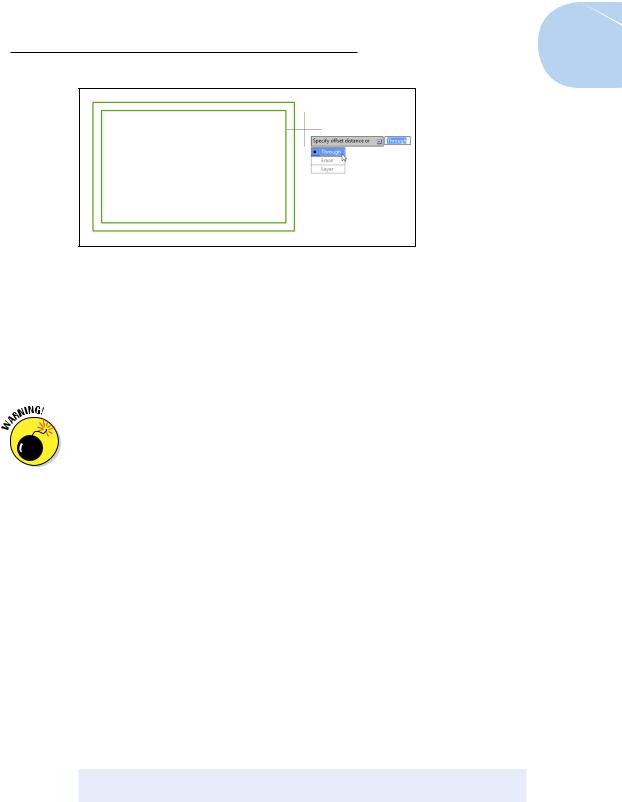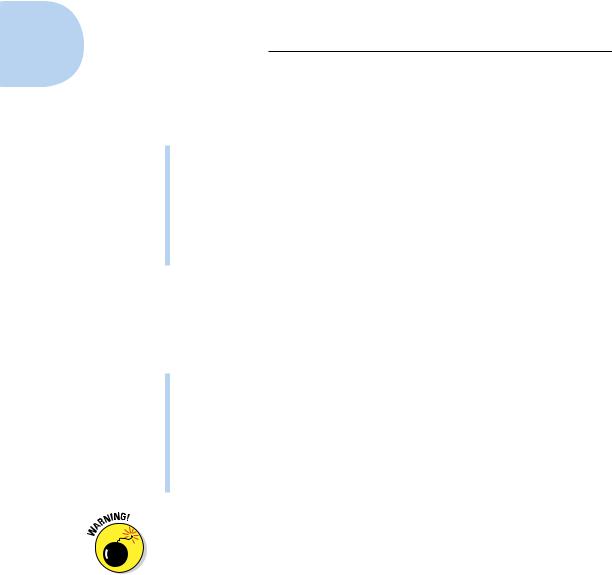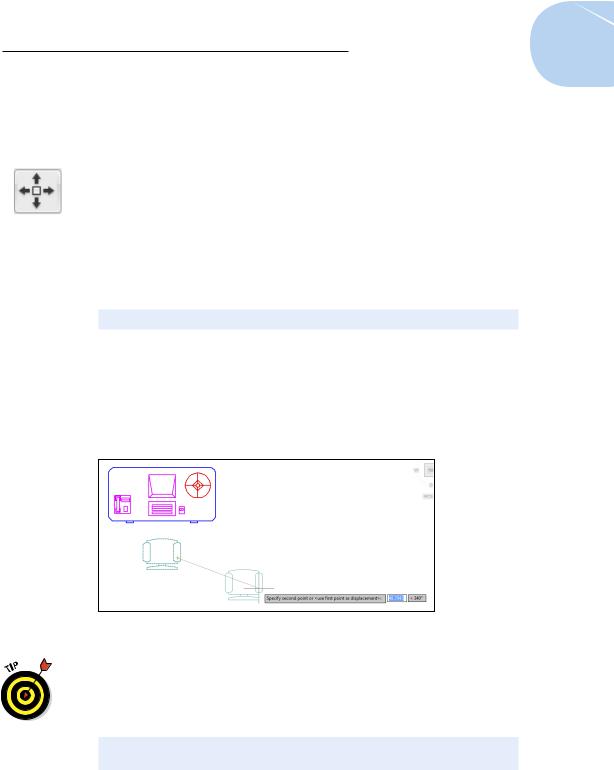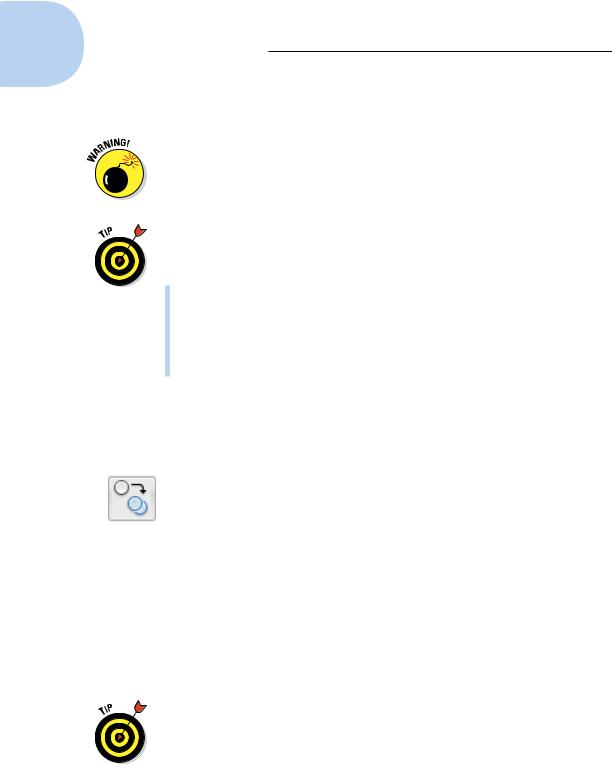
- •About the Authors
- •Dedication
- •Authors’ Acknowledgments
- •Table of Contents
- •Introduction
- •What’s Not (And What Is) in This Book
- •Mac attack!
- •Who Do We Think You Are?
- •How This Book Is Organized
- •Part I: AutoCAD 101
- •Part II: Let There Be Lines
- •Part III: If Drawings Could Talk
- •Part IV: Advancing with AutoCAD
- •Part V: On a 3D Spree
- •Part VI: The Part of Tens
- •But wait . . . there’s more!
- •Icons Used in This Book
- •A Few Conventions — Just in Case
- •Commanding from the keyboard
- •Tying things up with the Ribbon
- •Where to Go from Here
- •Why AutoCAD?
- •The Importance of Being DWG
- •Seeing the LT
- •Checking System Requirements
- •Suddenly, It’s 2013!
- •AutoCAD Does Windows (And Office)
- •And They’re Off: AutoCAD’s Opening Screens
- •Running with Ribbons
- •Getting with the Program
- •Looking for Mr. Status Bar
- •Let your fingers do the talking: The command window
- •The key(board) to AutoCAD success
- •Keeping tabs on palettes
- •Down the main stretch: The drawing area
- •Fun with F1
- •A Simple Setup
- •Drawing a (Base) Plate
- •Drawing rectangles on the right layers
- •Circling your plate
- •Nuts to you
- •Getting a Closer Look with Zoom and Pan
- •Modifying to Make It Merrier
- •Hip-hip-array!
- •Stretching out
- •Crossing your hatches
- •Following the Plot
- •A Setup Roadmap
- •Choosing your units
- •Weighing up your scales
- •Thinking annotatively
- •Thinking about paper
- •Defending your border
- •A Template for Success
- •Making the Most of Model Space
- •Setting your units
- •Making the drawing area snap-py (and grid-dy)
- •Setting linetype and dimension scales
- •Entering drawing properties
- •Making Templates Your Own
- •Setting Up a Layout in Paper Space
- •Will that be tabs or buttons?
- •View layouts Quick(View)ly
- •Creating a layout
- •Copying and changing layouts
- •Lost in paper space
- •Spaced out
- •A view(port) for drawing in
- •About Paper Space Layouts and Plotting
- •Managing Your Properties
- •Layer one on me!
- •Accumulating properties
- •Creating new layers
- •Manipulating layers
- •Using Named Objects
- •Using AutoCAD DesignCenter
- •Copying layers between drawings
- •Controlling Your Precision
- •Keyboard capers: Coordinate input
- •Understanding AutoCAD’s coordinate systems
- •Grab an object and make it snappy
- •Other Practical Precision Procedures
- •Introducing the AutoCAD Drawing Commands
- •The Straight and Narrow: Lines, Polylines, and Polygons
- •Toeing the line
- •Connecting the lines with polyline
- •Squaring off with rectangles
- •Choosing your sides with polygon
- •(Throwing) Curves
- •Going full circle
- •Arc-y-ology
- •Solar ellipses
- •Splines: The sketchy, sinuous curves
- •Donuts: The circles with a difference
- •Revision clouds on the horizon
- •Scoring Points
- •Commanding and Selecting
- •Command-first editing
- •Selection-first editing
- •Direct object manipulation
- •Choosing an editing style
- •Grab It
- •One-by-one selection
- •Selection boxes left and right
- •Perfecting Selecting
- •AutoCAD Groupies
- •Object Selection: Now You See It . . .
- •Get a Grip
- •About grips
- •A gripping example
- •Move it!
- •Copy, or a kinder, gentler Move
- •A warm-up stretch
- •Your AutoCAD Toolkit
- •The Big Three: Move, Copy, and Stretch
- •Base points and displacements
- •Move
- •Copy
- •Copy between drawings
- •Stretch
- •More Manipulations
- •Mirror
- •Rotate
- •Scale
- •Array
- •Offset
- •Slicing, Dicing, and Splicing
- •Trim and Extend
- •Break
- •Fillet and Chamfer and Blend
- •Join
- •When Editing Goes Bad
- •Zoom and Pan with Glass and Hand
- •The wheel deal
- •Navigating your drawing
- •Controlling your cube
- •Time to zoom
- •A View by Any Other Name . . .
- •Looking Around in Layout Land
- •Degenerating and Regenerating
- •Getting Ready to Write
- •Simply stylish text
- •Taking your text to new heights
- •One line or two?
- •Your text will be justified
- •Using the Same Old Line
- •Turning On Your Annotative Objects
- •Saying More in Multiline Text
- •Making it with Mtext
- •It slices; it dices . . .
- •Doing a number on your Mtext lists
- •Line up in columns — now!
- •Modifying Mtext
- •Gather Round the Tables
- •Tables have style, too
- •Creating and editing tables
- •Take Me to Your Leader
- •Electing a leader
- •Multi options for multileaders
- •How Do You Measure Up?
- •A Field Guide to Dimensions
- •The lazy drafter jumps over to the quick dimension commands
- •Dimension associativity
- •Where, oh where, do my dimensions go?
- •The Latest Styles in Dimensioning
- •Creating and managing dimension styles
- •Let’s get stylish!
- •Adjusting style settings
- •Size Matters
- •Details at other scales
- •Editing Dimensions
- •Editing dimension geometry
- •Editing dimension text
- •Controlling and editing dimension associativity
- •Batten Down the Hatches!
- •Don’t Count Your Hatches. . .
- •Size Matters!
- •We can do this the hard way. . .
- •. . . or we can do this the easy way
- •Annotative versus non-annotative
- •Pushing the Boundary (Of) Hatch
- •Your hatching has no style!
- •Hatch from scratch
- •Editing Hatch Objects
- •You Say Printing, We Say Plotting
- •The Plot Quickens
- •Plotting success in 16 steps
- •Get with the system
- •Configure it out
- •Preview one, two
- •Instead of fit, scale it
- •Plotting the Layout of the Land
- •Plotting Lineweights and Colors
- •Plotting with style
- •Plotting through thick and thin
- •Plotting in color
- •It’s a (Page) Setup!
- •Continuing the Plot Dialog
- •The Plot Sickens
- •Rocking with Blocks
- •Creating Block Definitions
- •Inserting Blocks
- •Attributes: Fill-in-the-Blank Blocks
- •Creating attribute definitions
- •Defining blocks that contain attribute definitions
- •Inserting blocks that contain attribute definitions
- •Edit attribute values
- •Extracting data
- •Exploding Blocks
- •Purging Unused Block Definitions
- •Arraying Associatively
- •Comparing the old and new ARRAY commands
- •Hip, hip, array!
- •Associatively editing
- •Going External
- •Becoming attached to your xrefs
- •Layer-palooza
- •Creating and editing an external reference file
- •Forging an xref path
- •Managing xrefs
- •Blocks, Xrefs, and Drawing Organization
- •Mastering the Raster
- •Attaching a raster image
- •Maintaining your image
- •Theme and Variations: Dynamic Blocks
- •Lights! Parameters!! Actions!!!
- •Manipulating dynamic blocks
- •Maintaining Design Intent
- •Defining terms
- •Forget about drawing with precision!
- •Constrain yourself
- •Understanding Geometric Constraints
- •Applying a little more constraint
- •AutoConstrain yourself!
- •Understanding Dimensional Constraints
- •Practice a little constraint
- •Making your drawing even smarter
- •Using the Parameters Manager
- •Dimensions or constraints — have it both ways!
- •The Internet and AutoCAD: An Overview
- •You send me
- •Send it with eTransmit
- •Rapid eTransmit
- •Bad reception?
- •Help from the Reference Manager
- •Design Web Format — Not Just for the Web
- •All about DWF and DWFx
- •Autodesk Design Review 2013
- •The Drawing Protection Racket
- •Autodesk Weather Forecast: Increasing Cloud
- •Working Solidly in the Cloud
- •Free AutoCAD!
- •Going once, going twice, going 123D
- •Your head planted firmly in the cloud
- •The pros
- •The cons
- •Cloudy with a shower of DWGs
- •AutoCAD 2013 cloud connectivity
- •Tomorrow’s Forecast
- •Understanding 3D Digital Models
- •Tools of the Trade
- •Warp speed ahead
- •Entering the third dimension
- •Untying the Ribbon and opening some palettes
- •Modeling from Above
- •Using 3D coordinate input
- •Using point filters
- •Object snaps and object snap tracking
- •Changing Planes
- •Displaying the UCS icon
- •Adjusting the UCS
- •Navigating the 3D Waters
- •Orbit à go-go
- •Taking a spin around the cube
- •Grabbing the SteeringWheels
- •Visualizing 3D Objects
- •Getting Your 3D Bearings
- •Creating a better 3D template
- •Seeing the world from new viewpoints
- •From Drawing to Modeling in 3D
- •Drawing basic 3D objects
- •Gaining a solid foundation
- •Drawing solid primitives
- •Adding the Third Dimension to 2D Objects
- •Creating 3D objects from 2D drawings
- •Modifying 3D Objects
- •Selecting subobjects
- •Working with gizmos
- •More 3D variants of 2D commands
- •Editing solids
- •Get the 2D Out of Here!
- •A different point of view
- •But wait! There’s more!
- •But wait! There’s less!
- •Do You See What I See?
- •Visualizing the Digital World
- •Adding Lighting
- •Default lighting
- •User-defined lights
- •Sunlight
- •Creating and Applying Materials
- •Defining a Background
- •Rendering a 3D Model
- •Autodesk Feedback Community
- •Autodesk Discussion Groups
- •Autodesk’s Own Bloggers
- •Autodesk University
- •The Autodesk Channel on YouTube
- •The World Wide (CAD) Web
- •Your Local ATC
- •Your Local User Group
- •AUGI
- •Books
- •Price
- •3D Abilities
- •Customization Options
- •Network Licensing
- •Express Tools
- •Parametrics
- •Standards Checking
- •Data Extraction
- •MLINE versus DLINE
- •Profiles
- •Reference Manager
- •And The Good News Is . . .
- •APERTURE
- •DIMASSOC
- •MENUBAR
- •MIRRTEXT
- •OSNAPZ
- •PICKBOX
- •REMEMBERFOLDERS
- •ROLLOVERTIPS
- •TOOLTIPS
- •VISRETAIN
- •And the Bonus Round
- •Index

Chapter 11: Edit for Credit 219
Figure 11-1: Choosing command options from the Dynamic Input menu.
As we describe in Chapter 7, maintaining precision when you draw and edit is crucial to good CAD work. If you’ve used a drawing program and are accustomed to moving, stretching, and otherwise editing objects by eye, you’ll need to suppress that habit when you edit in AutoCAD. Nothing ruins a drawing faster than eyeball editing, in which you shove objects around until they look okay, without worrying about precise distances and points.
Users of Windows Paint and other bitmap drawing programs will be familiar with the concept of “nudging” — selecting some objects and using the arrow keys to move them a certain number of pixels horizontally or vertically. For better or worse, AutoCAD has joined the nudging party. You can move objects a pixel’s-worth this way or that by holding down Ctrl and pressing an arrow key. When working with AutoCAD, you should always use tried-and-true precision drafting techniques, and moving objects by the pixel instead of by realworld units is the opposite of precise. It might be okay to move a piece of text by nudging it, but you should never move actual drawing geometry that way.
The Big Three: Move, Copy, and Stretch
Moving, copying, and stretching are, for many drafters, the three most common editing operations. AutoCAD obliges this need with the MOVE, COPY, and STRETCH commands.
Base points and displacements
The MOVE, COPY, and STRETCH commands all require that you specify how far and in what direction you want the objects to be moved, copied, or stretched. After you’ve started the command and selected the objects to be edited, AutoCAD prompts you for two pieces of information:
Specify base point or [Displacement] <Displacement>:
Specify second point or <use first point as displacement>:
www.it-ebooks.info

220 Part II: Let There Be Lines
In a subtle way, these prompts say that two possible methods exist for you to specify how far and in what direction you want the objects copied, moved, or stretched:
The most common way is to pick or type the coordinates of two points that define a displacement vector. AutoCAD calls these points the base point and the second point. Imagine an arrow pointing from the base point to the second point — that arrow defines how far, and in what direction, the objects are copied, moved, or stretched.
The other way is to type an X,Y pair of numbers that represents a distance rather than a point. This distance is the absolute displacement that you want to copy, move, or stretch the objects.
How does AutoCAD know whether your response to the first prompt is a base point or a displacement? It depends on how you respond to the second prompt. It might seem a little confusing at first, but it’s actually quite simple. First, you pick a point onscreen or enter coordinates at the Base point prompt. Next, there are a couple of possibilities:
If you then pick or type the coordinates of a point at the second point prompt, AutoCAD says to itself, “Aha — displacement vector!,” and moves the objects according to the imaginary arrow pointing from the base point to the second point.
If you press Enter at the second prompt (without having typed anything), AutoCAD says, “Aha — displacement distance,” and uses the X,Y pair of numbers that you typed at the first prompt as an absolute displacement distance.
What makes this displacement business interesting is that AutoCAD lets you pick a point at the first prompt and then press Enter at the second prompt. AutoCAD still says, “Aha — displacement distance,” but now it treats the coordinates of the point you picked as an absolute distance relative to the drawing’s origin. If the point you picked has relatively large coordinates, the objects can be moved to somewhere northeast of Greenland. You probably won’t see where they’ve gone because you’re zoomed into part of your normal drawing area, and so it just seems like the objects have vanished!
In short, be careful when you press Enter during the MOVE, COPY, and STRETCH commands. Press Enter in response to the second prompt only if you want AutoCAD to use your response to the first prompt as an absolute displacement. If you make a mistake, click Undo or press Ctrl+Z to back up and try again. You can use Zoom Extents (described in Chapter 12) to look for objects that have flown off into space.
Move
The following steps demonstrate command-first editing with the MOVE command, using the base point method of indicating how far and in what
www.it-ebooks.info

Chapter 11: Edit for Credit 221
direction to move the selected objects. This procedure also gives detailed recommendations on how to use precision techniques when you edit.
1.Press Esc to make sure that no command is active and no objects are selected.
2.Click the Move button on the Modify panel of the Home tab.
The command line displays the Select objects prompt.
3.Select one or more objects.
You can use any of the object selection techniques described in the “Perfecting Selecting” section in Chapter 10.
4.Press Enter when you’re finished selecting objects.
AutoCAD displays the following prompt:
Specify base point or [Displacement] <Displacement>:
5.Specify a base point by clicking a point or typing coordinates.
This point serves as the tail end of your imaginary arrow that indicates how far and in what direction you want the objects moved. After you pick a base point, it’s fairly easy to see what’s going on because
AutoCAD displays a temporary image of the object that moves around as you move the crosshairs. Figure 11-2 shows what the screen looks like.
Figure 11-2: Dragging objects in the middle of the MOVE command.
Specify a base point somewhere on or near the object(s) that you’re moving. You can use an object snap mode to choose a point exactly on one of the objects.
AutoCAD displays the following prompt:
Specify second point or <use first point as displacement>:
6. Specify the second point by clicking a point or typing coordinates.
www.it-ebooks.info

222 Part II: Let There Be Lines
The second point serves as the arrow end of your imaginary displacement arrow. After you specify the second point, AutoCAD moves the objects.
Don’t press Enter alone at this prompt! If you do, AutoCAD treats the X,Y coordinates of the first point you picked as an absolute displacement, and the objects fly off unpredictably. I repeat: Don’t press Enter alone at this prompt! As indicated in the previous warning, pressing Enter without picking a point or typing coordinates at this prompt is one of the most common errors new AutoCAD users make, and it can really pollute your drawing with unwanted objects.
These are the common precision techniques for specifying the second point:
Use an object snap mode to pick a second point exactly on another object in the drawing.
Type a relative or polar coordinate, as described in Chapter 7. For example, if you type @6,2, AutoCAD moves the objects 6 units to the right and 2 units up. If you type @3<45, AutoCAD moves the objects 3 units at an angle of 45 degrees.
Use direct distance entry to move objects in an orthogonal or polar-tracking direction. See Chapter 7 for instructions.
Copy
The COPY command works almost identically to the MOVE command, except that AutoCAD leaves the selected objects in place and makes new copies of them in the new location.
The COPY command creates multiple copies by default. If you want only one copy, press Enter after placing it in the drawing. Choosing mOde at the command prompt or the Dynamic Input options list lets you switch between making a single copy and multiple copies. If you mostly make multiple copies or mostly make single copies, you’ll appreciate being able to change the default setting.
The COPY command includes an Array option. In addition to plunking copied objects down just anywhere, typing A to choose the Array option lets you specify spacing for an evenly laid-out linear array. That’s good if you just want a single row of copies, but the ARRAY command (which we describe later in this chapter and in Chapter 18) is required to create rows and columns or circular patterns of copied objects.
The COPY command includes an Undo option with which you can roll back multiple copies within a single COPY operation.
www.it-ebooks.info
